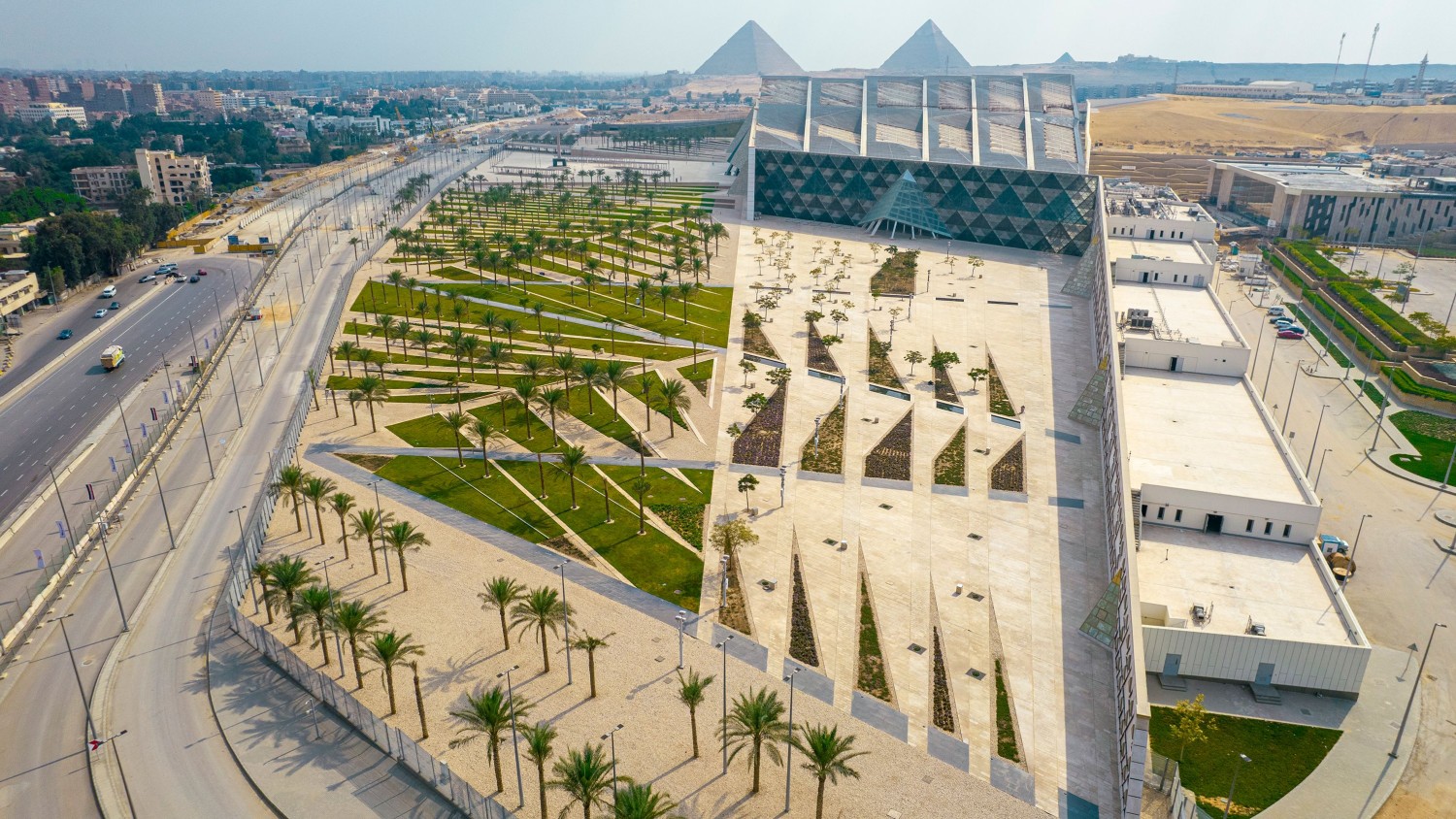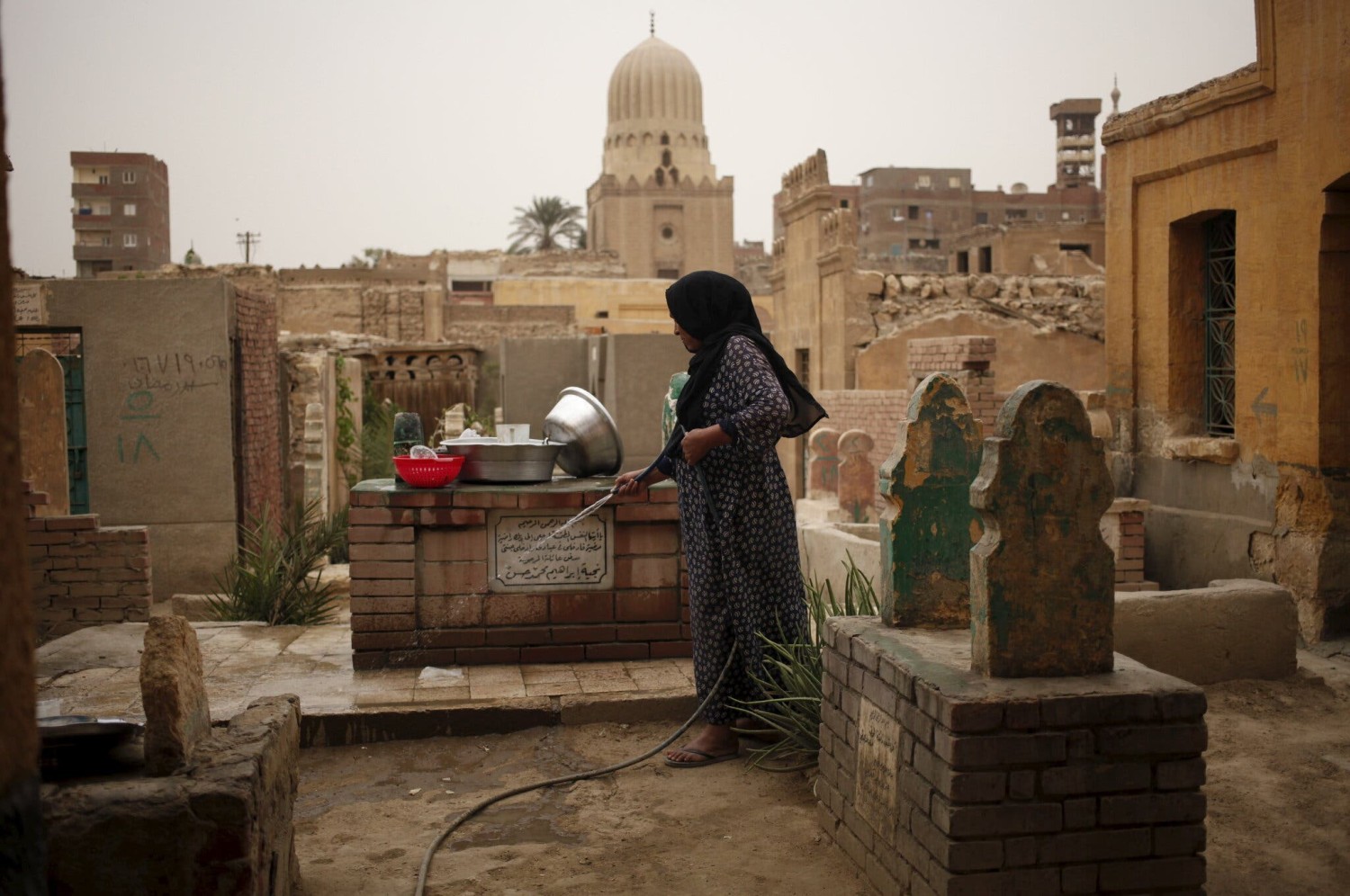
This article is more than
3 year old
My mother, who died suddenly when I was a teenager, is buried alongside her ancestors in a historic mausoleum in the area of Cairo known as the City of the Dead. It’s the oldest continuously used Muslim cemetery in the world, and its history traces back to the seventh century. My ancestors chose this burial place in order to be near Imam al-Shafi’i, a ninth-century holy man who rests in a magnificent shrine there. My family has five mausolea in the vicinity; the oldest is from the 1790s. From the outside they resemble the courtyarded houses of medieval Cairo. Inside there are gardens, carved marble cenotaphs and ornately decorated rooms, hung with dusty chandeliers, where grievers used to hold all-night vigils on holidays and death anniversaries.
For the most part, the tradition of spending the night among the dead has itself died out, but many of these rooms are still inhabited by families: at least half a million — perhaps several times that number — of Egypt’s poorest live in and among the tombs. Undertakers, calligraphers, caretakers, florists, masons and professional mourners have for many generations resided in the homes built by Cairenes for their dead. The City of the Dead has always been a city of the living as well.
I’ve been visiting my mother’s grave regularly for 22 years. I have gotten to know some of the families that live in and care for our mausolea and who hang their laundry across the tombs to dry in the breeze. My visits, and the small acts of tending to the dead, helped me make meaning out of a meaningless loss. We planted bougainvillea and set up umbrellas to shade the courtyard where we offer prayers. During my visits I became interested both in the history of my own family and of Egypt. With access to the national archives largely forbidden by state security — it only wants to admit those friendly to nationalist narratives — I made the cemetery an archive of my own. The City of the Dead does not just house my own personal memories; it is one of the last remaining open repositories of Egypt’s historical memory.
Now the dead are being exhumed, the living are being evicted, and the historic buildings that house them both are being bulldozed. The City of the Dead is being razed to make way for a highway cruelly named the Passage of Paradise, a series of flyover bridges that the government claims will relieve some of Cairo’s notorious traffic congestion. This project, ongoing since 2019, is now ramping up. The highway will connect the city with the new administrative capital that President Abdel Fattah el-Sisi is constructing at the expected cost of $59 billion.
It’s all part of Mr. Sisi’s plan for the so-called modernization of Cairo: a series of projects that involve eliminating neighborhoods, displacing hundreds of thousands of people and demolishing centuries-old buildings in the name of development. My outrage at this violent erasure of history isn’t borne out of a romantic or aesthetic attachment to the past, or even the possible loss of my mother’s grave. It’s because these demolitions are part of a larger plan, with terrifying implications for democracy and demography alike.

Over the past decade, a series of wildly unpopular mass evictions have become critical to realizing the generals’ vision of development — and the state’s violently enforced version of history has been used to deny families their homes. Since 2017, Mr. Sisi’s government has been trying to evict some 200,000 residents of al-Warraq Island, many of whose families have lived on this island in the Nile for hundreds of years, to make way for luxury skyscrapers. Officials claim that residents are squatters, even though many of these families have legal documents to prove their rights to remain on their ancestral land.
Similarly, in 2018, more than 4,000 families were forcibly expelledfrom an 86-acre area in downtown Cairo that was leveled for commercial use by a global architecture firm. Under the guise of protecting the area’s residents from unsafe housing, the evictions and ensuing demolitions cleared a large swathe of downtown Cairo’s 19th-century architecture and gave thin cover to a land grab of some of its most highly prized real estate.
For me, the connection between history and Cairo’s built environment is inextricable. It was from the City of the Dead’s ornate marble sepulchers that I learned, as a teenager, about Egypt’s short-lived and flawed experiments with democracy. Buried within my family’s mausolea is an ancestor who was elected to govern Egypt under Napoleon in the 1790s, as well as another who helped Egypt win independence from British imperialism in 1922. Nearby is another ancestor who oversaw the writing of the 1923 Constitution that established a democracy in the country for the first time. My mother’s grandfather, whom she adored and wanted to be buried next to, was a member of a three-man regency council in 1952 and oversaw the transformation of Egypt from monarchy to republic.
Mr. Sisi isn’t just indifferent to modern Egypt’s history, he resents it. The histories that I learned of from the City of the Dead get in the way of a putatively pristine Pharaonic past. In 2021, Mr. Sisi orchestrated a military parade of royal mummies to drum up support for a potential war against Ethiopia. The ruling military clique effaced all signs of the Arab Spring of 2011 on Tahrir Square by cobbling together a martial monument of rams and obelisks pillaged from ancient sites. Recently, Cairo’s municipal government announced that it intends to rename al-Warraq Island after the ancient deity Horus.
Mr. Sisi’s inspiration may be Pharaonic, but his rule recalls less glorious episodes of modern history. His exorbitant megaprojects, like the new administrative capital, resemble those of the country’s loathed 19th-century Ottoman governor Ismail Pasha, who similarly engaged in large-scale building works, borrowed heavily from foreign creditors and was as a result deposed following a popular uprising. For Mr. Sisi, the 19th and 20th centuries — associated with revolutionary politics, the battle for democracy and resistance to “modernization” efforts under previous governments experienced by millions as violent dispossession — have to be erased. Instead, the state expresses the generals’ uncompromising, totalitarian vision by recalling an ancient culture in which sovereigns were deities.

Despite the violence that activists in Egypt persistently face (there are, by the estimate of one Egyptian human rights group, some 65,000 political prisoners; at least 1,000 have been killed in state custody on Mr. Sisi’s watch), there has been considerable anger and even heroic resistance to the razing of the City of the Dead. Scores of art students defied military orders by marching to the area to document the imminent demolitions, and several were arrested. Five members of the council appointed to examine the destruction — a fig leaf set up by the government in response to public anger — resigned loudly despite considerable government pressure to stay on.
The anger of Cairenes has been compounded by the silence of global organizations, which many feel have abandoned them. The City of the Dead is a part of historic Cairo, a World Heritage Site and so under United Nations’ legal protection ratified by Egypt. Activists feel that UNESCO, the United Nations cultural organization, should at the very least sound alarm bells about the irreversible damage underway. Khaled al-Anani, Egypt’s former minister of antiquities and tourism who oversaw the delisting of many historical monuments, has now launched a campaign to serve as UNESCO’s next director general. The demolition of the City of the Dead is a blight on Mr. Anani’s record, and one that should disqualify him.
Egypt’s assault on history and homes is a dangerous one for powers like the United States that rely on Egypt for regional stability. If nothing else, mass evictions could destabilize a nation teetering on the brink of bankruptcy. That instability will only increase through Mr. Sisi’s ecologically disastrous megaprojects: The new administrative capital requires vast quantities of water to be diverted to the desert just as pouring concrete onto the once verdant gardens of the City of the Dead threatens Cairo’s last remaining green spaces.
As the effacement of my mother’s grave seems imminent, I am faced with an unenviable choice. I could either relocate her body and the marble tombstones of my ancestors to new sites on the outskirts of Cairo, in that way doing the government’s bidding pre-emptively. Or I could insist that they will not be moved, and risk having my mother’s corpse crushed by a bulldozer.
My predicament, and that of hundreds of families in my position, is a symbol of the unspeakable dehumanization that Egyptians are suffering under the military junta. Given the deadly price so many Egyptians have paid to speak out against his policies, Mr. Sisi’s glitzy new capital, if it ever gets constructed, will be our next City of the Dead, built over the bones of the disinterred and those whom the regime has killed.
Hussein Omar is writing a 500-year family history based on research conducted in the City of the Dead.
The Times is committed to publishing a diversity of letters to the editor. We’d like to hear what you think about this or any of our articles. Here are some tips. And here’s our email: letters@nytimes.com.
Follow The New York Times Opinion section on Facebook, Twitter (@NYTopinion) and Instagram.